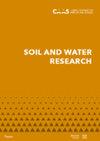Sponge effect of aerated concrete on phosphorus adsorption-desorption from agricultural drainage water in rainfall
IF 1.7
4区 农林科学
Q4 SOIL SCIENCE
引用次数: 2
Abstract
In the initial stage of the rainfall, the nutrient element phosphorus (P) in the farmland, one of the most important factors causing agricultural non-point source pollution, flows into agriculture drainage ditches rapidly, and an instantaneous phosphorus peak value in the ditch water often occurs. Aerated concrete with high P adsorption properties was chosen as the experiment material in the laboratory to reduce the instantaneous P peak value in the drainage water in the initial stage of the rainfall. The three total P (TP) concentrations of the simulated drainage water (1.0, 2.0, and 3.0 mg/L) stood for three treatments were designed in the adsorption experiment; the same three TP concentrations of the simulated drainage water and the three TP concentrations of the simulated natural water (0.2, 0.3, and 0.4 mg/L) stood for nine treatments in the desorption experiment. The sponge effect of the aerated concrete on the P adsorption-desorption was explored by studying the dynamics of the P adsorption-desorption of the aerated concrete with an increase in the experiment’s time. The results showed the following details: (1) Both the adsorption rate and desorption rate of the aerated concrete decrease with an increase in the experiment’s time. The initial adsorption is dominant during the entire adsorption, as with the initial desorption during the entire desorption. (2) The adsorption capacity of the aerated concrete slightly decreases with the increase in the re-adsorption, whereas the desorption capacity of the aerated concrete significantly decreases with the increase in the re-desorption. Thus, the aerated concrete can be introduced into the agricultural drainage ditch to reduce the instantaneous P peak value in the drainage water in the initial stage of the rainfall, and potential further studies should explore the relationship between the different drainage water loads and the amount of the aerated concrete.降雨条件下加气混凝土对农业排水磷吸附解吸的影响
降雨初期,农田中的营养元素磷(P)作为造成农业面源污染的最重要因素之一,迅速流入农业排水沟,沟渠水中经常出现瞬时磷峰值。实验室选用高磷吸附性能的加气混凝土作为实验材料,降低降雨初期排水中的瞬时P峰值。在吸附实验中设计了3种处理下模拟排水的总磷浓度(1.0、2.0和3.0 mg/L);在解吸实验中,模拟排水的三种TP浓度与模拟天然水的三种TP浓度(0.2、0.3、0.4 mg/L)相同。通过研究加气混凝土对磷的吸附-解吸随试验时间增加的动态变化规律,探讨加气混凝土对磷吸附-解吸的海绵效应。结果表明:(1)加气混凝土的吸附速率和解吸速率均随实验时间的增加而降低。在整个吸附过程中,初始吸附占主导地位,在整个脱附过程中,初始脱附也占主导地位。(2)加气混凝土的吸附能力随着再吸附量的增加而略有下降,而加气混凝土的解吸能力随着再吸附量的增加而显著降低。因此,可以在农业排水沟中引入加气混凝土,以降低降雨初期排水中的瞬时P峰值,潜在的进一步研究应探讨不同排水荷载与加气混凝土用量之间的关系。
本文章由计算机程序翻译,如有差异,请以英文原文为准。
求助全文
约1分钟内获得全文
求助全文
来源期刊

Soil and Water Research
Water resources, Soil Science, Agriculture-WATER RESOURCES
CiteScore
4.60
自引率
0.00%
发文量
26
审稿时长
>12 weeks
期刊介绍:
An international peer-reviewed journal published under the auspices of the Czech Academy of Agricultural Sciences and financed by the Ministry of Agriculture of the Czech Republic. Published since 2006.
Thematic: original papers, short communications and critical reviews from all fields of science and engineering related to soil and water and their interactions in natural and man-modified landscapes, with a particular focus on agricultural land use. The fields encompassed include, but are not limited to, the basic and applied soil science, soil hydrology, irrigation and drainage of lands, hydrology, management and revitalisation of small water streams and small water reservoirs, including fishponds, soil erosion research and control, drought and flood control, wetland restoration and protection, surface and ground water protection in therms of their quantity and quality.
 求助内容:
求助内容: 应助结果提醒方式:
应助结果提醒方式:


